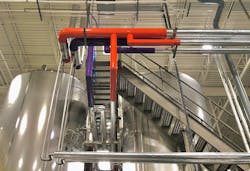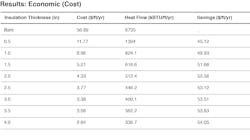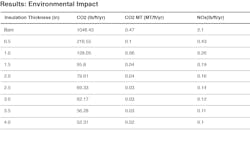How to Curb Energy and Emissions in Mechanical Piping Systems
Walking through a facility’s mechanical room recently, it occurred to me that small improvements to piping systems can have an effect on a building’s energy efficiency. Given that 16% of greenhouse gas (GHG) emissions are from commercial buildings, there is a tremendous opportunity for building owners, facility managers and contractors to help reduce energy use and emissions.
New clean technologies along with federal incentives to retrofit energy systems are getting a lot of attention although many details are still being addressed. However, there are longstanding practices that can be deployed today to reduce energy loss in commercial buildings such as schools, hospitals, and office buildings.
As we’ll discuss below, thermal insulation is a highly effective technology to conserve energy, save money, and reduce CO2 created by process steam pipes. Even at very modest thickness levels, fiberglass insulation installed on mechanical piping systems—particularly steam pipes—can reduce energy and emissions.
Doing the Energy and Emissions Math
Calculations conducted using the North American Insulation Manufacturers Association’s (NAIMA) free 3E Plus® software show the economic damage that can result from compromised or missing insulation. A steam line of 3-inch pipe running at 350 degrees F. in an environment with a very warm ambient temperature of 100 degrees F. provides a good example.
In this example, one foot of damaged or missing insulation will impose a cost of $56.89 per foot per year (based on input energy costs) to maintain the heat loss (Figure 1). Adding just 2 inches of insulation to the 3-inch pipe section takes the annual cost down to $4.33—a savings of $52.56 for just one year. Considering that most environments will offer hundreds of feet of opportunity to insulate or maintain the insulation in a building, the savings add up quickly.
As energy consumption is reduced, emissions are also lowered. Again, calculations conducted using NAIMA’s 3E Plus® software show that the damaged or missing 1-foot section of insulation will create 1046.43 pounds of CO2, compared to a steam line insulated with 2 inches of fiberglass insulation, which will produce just 79.61 pounds of CO2 annually (Figure 2).
The type of process pipe can influence the opportunity for insulation to conserve energy costs. As chilled water pipes are not subject to the same temperature differential between pipe and ambient temperature, energy loss in chilled water pipes is much lower. For example, the NAIMA 3E Plus® software indicates that a 3-inch chilled water line operating at 50 degrees F. will impose a cost of only $2.59 per foot per year to maintain the temperature with one foot of damaged/missing insulation.
Looking at emissions, the carbon created to cool the 1-foot section would be 47.6 pounds annually on a pipe with 1 foot of damaged/missing insulation. Adding 2 inches of insulation would result in a savings of $2.32 per year. Thus, when it comes to insulation as an opportunity to conserve energy and emissions, process steam pipes should typically be prioritized over chilled water pipes.
Free Resources to Calculate Potential Savings
Building owners and facility managers can input the data from their building to identify opportunities for conserving energy and emissions. The NAIMA 3E Plus® software can be accessed here and downloaded for free. The resource makes it easy to calculate heat losses and determine surface temperatures on hot and cold piping equipment. The software uses the heat flow calculation method described in ASTM C680, “Standard Practices for Determination of Heat Gain or Loss and the Surface Temperature of Insulated Piping on Equipment Systems by the Use of a Computer System.”
By inputting the local energy codes, temperatures of process pipes, ambient conditions, etc. the tool can also alert users to conditions that could indicate an issue.
Beyond Energy—Other Piping Issues to Consider
In addition to energy and emission considerations, adequate levels of insulation and proper jacketing around systems can safeguard against problems posed by moisture and contribute to the longevity of piping systems. Wet areas on the ceiling, dripping pipes or moisture collection on pipes can all be indicators of a problem that may potentially threaten the building structure and equipment.
An oft-ignored fact is that energy codes do not always protect against condensation. The accumulation of condensation resulting from moisture egress can occur anytime the surface is cooler than the dew point of the air that surrounds it. While a pipe may meet energy code, these codes don’t address all the potential risks posed by moisture.
Wet surfaces can create conditions for molds to form, proliferate and adversely affect the quality of indoor air. Freeze protection is another concern not addressed in the code. The epic ice storm that brought much of Houston to a halt in February 2021 provides an example of the risks posed to piping in unheated environments. Temperature should be considered in context with flow rate in process pipes given that when the flow rate is less, freezing will occur more quickly. While the NAIMA 3E Plus® software will not calculate insulation thicknesses for freeze protection, Owens Corning Product Technical Managers can provide calculations upon request.
New innovations are continuing to make buildings resilient, energy efficient and comfortable. However, implementing tried and true practices such as assuring adequate levels of insulation on process pipes and ensuring pipes are properly maintained also can deliver improvements that solve for energy and economics. Applying technologies like the 3E Plus® software can help professionals access the full energy saving potential of pipe insulation.
About the Author
Bill Tolliver
Bill Tolliver is the product technical manager, pipe and mechanical insulation, for Owens Corning.


